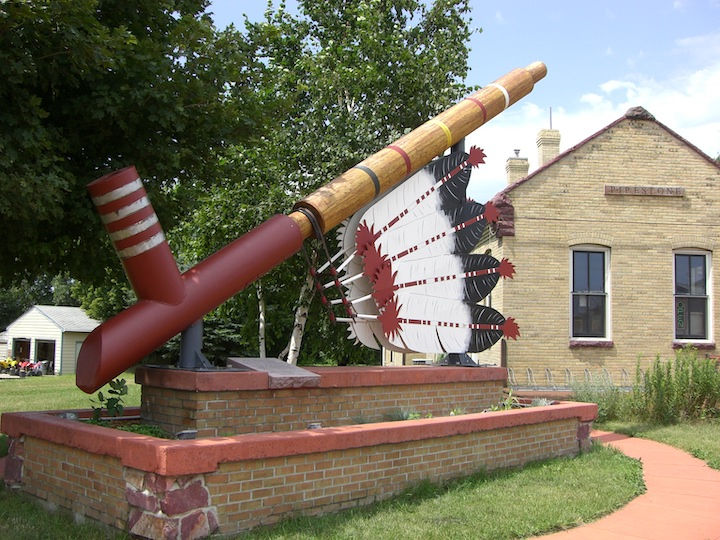What Is A Pipe Ceremony?
- Ken Cohen
- Aug 20, 2024
- 4 min read
Updated: Aug 24, 2024
©Kenneth S. Cohen

Statue of a Native American ceremonial pipe outside the shop and headquarters of the Keepers of the Sacred Tradition of Pipemakers, Pipestone, Minnesota
The Way of the Pipe is my religion, my spiritual path. I practice it in the church of Nature either by myself or with a circle of other worshippers. In the Pipe, all comes to unity. As I join the long wooden stem to the red pipestone bowl, I acknowledge the first two realms of life on earth: stone and plant, stillness and movement, the supple growing green of the plant people and the quiet strength of the stone and mountain people. As the feminine bowl receives the masculine stem, the importance of male/female balance and harmony is affirmed within each of us, whether you personally identify as male or female. I fill the Pipe with a mixture of natural tobacco and herbs that I have gathered with prayer: red willow bark, sage, bearberry, mullein, and other healing herbs. (Marijuana and recreational drugs are never smoked in the Sacred Pipe.) Holding each pinch of the mixture briefly in my fingers then placing it in the bowl, I invite spiritual presences to enter the Pipe and join the ceremony: the Four Winds, Mother Earth, the Sun, Moon, Stars, the Great Spirit. All of Creation is in the Pipe.
Songs are shared, songs of gratitude, songs of respect, songs that communicate the values, philosophy, and procedures of a Pipe Ceremony. Though most songs are in a Native language, in my Pipe Ceremony, songs in any language are welcome as long as they are in harmony with the spirit of the Pipe. Each person in the circle has an opportunity to pray, to speak from the heart, and perhaps, if they are spiritually mature, from the heart of creation, not to sermonize, not to tell Creator what He/She already knows. Pray for what is good and meant to be. For healing, for wisdom, for peace, for others, and yes, for yourself. Pray out loud, not silently. There is no need to keep Pipe prayers within; they are meant to be given and heard, so that other participants can be blessed and encouraged by good words and intentions. Close your prayer with the words “All My Relations”, meaning that the prayer is intended for the good and harmony of all of our visible and invisible relations.
And then, the Pipe is smoked. Commonly, four or seven puffs, taken into the mouth—not inhaled-- and then released as an offering. The breath of life infuses the smoke and carries prayers to a mysterious realm beyond our knowledge and to Creator, the very source of the breath. As spirit opens beyond the doors of perception and the boundaries of ordinary knowledge, the Pipe becomes a two-way channel; you communicate with the Great Mystery (the Divine, God), and the Great Mystery may also communicate with you, offering information, insight, and guidance for self, community, society, and planet.
These are the basic elements of a Pipe Ceremony. It is not the whole ceremony. There are protocols to prepare for the ceremony, perhaps a period of fasting or certain activities to avoid during a number of days that precede the ceremony. Even before the pipestem and bowl are joined, the Pipe carrier and participants prepare themselves and their altar of ceremonial objects by cleansing or “smudging” in the smoke of a purification plant such as sage, sweetgrass, or cedar. Some Pipe ceremonies may include gestures or actions appropriate for specific purposes such as a healing, a wedding, a vision quest, preparation for military duty (in the past a “war party”), a celebration, or tribal event. My adoption into my Nehiyaw (Cree Indian) family included a Pipe Ceremony. Some pipe ceremonies are unique to individuals—perhaps received in vision or dream, and both procedures and materials used to make the pipe are as diverse as the more than 500 Nations that comprise indigenous North America.

Photo of First Nations Man offering the Pipe, displayed in Victoria, BC (Canada) Airport
There are many, many stories and teachings associated with the Pipe. It is a lifelong learning journey. To receive a Pipe is a great honor and responsibility; it is not for everyone. The Sacred Pipe is not something you decide to buy or to do (though a pipe or objects made of pipestone may be purchased and displayed as works of art, thus supporting the indigenous artists who work at or near the quarries). Creator gifts the Pipe by guiding an elder, a medicine person, or indigenous wisdom keeper to give it to you and perhaps the same person to “awaken” it in ceremony. And at least once in every Pipe carrier’s life it is good to bring the Pipe back home to its source to bless and be blessed at Pipestone, Minnesota, where Native craftspeople still quarry and carve the precious stone.

Travis Erickson (Sisseton Wahpeton Oyate), who learned to quarry and carve the Pipe
from his mother and male elders, photo by Ken Cohen at Pipestone Quarry, 2024

Comments